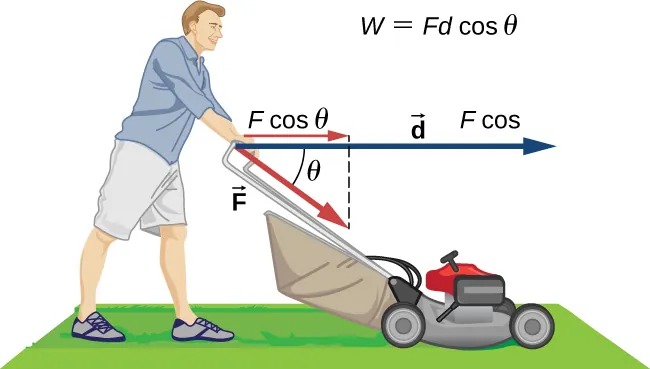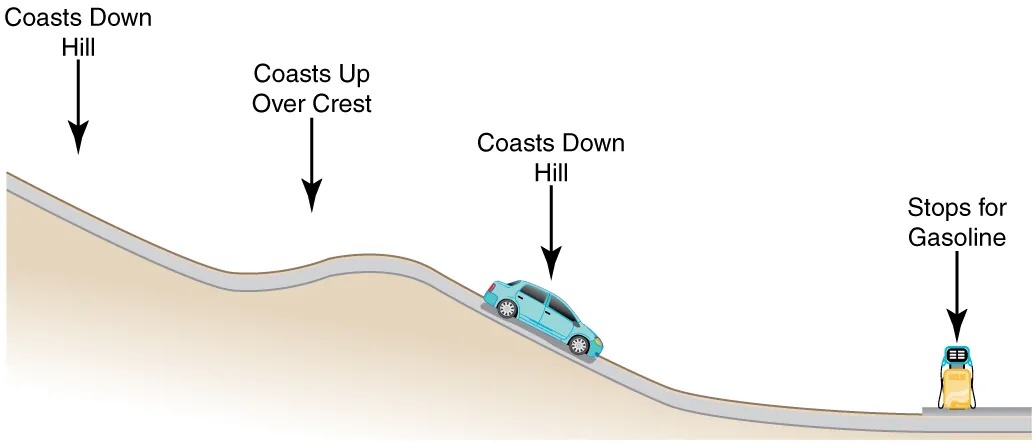Conceptual Questions
Conceptual Questions
6.1 Work: The Scientific Definition
- Give an example of something we think of as work in everyday circumstances that is not work in the scientific sense. Is energy transferred or changed in form in your example? If so, explain how this is accomplished without doing work.
- Give an example of a situation in which there is a force and a displacement, but the force does no work. Explain why it does no work.
- Describe a situation in which a force is exerted for a long time but does no work. Explain.
6.2 Kinetic Energy and the Work-Energy Theorem
- The person in Figure 6.30 does work on the lawn mower. Under what conditions would the mower gain energy? Under what conditions would it lose energy?

Figure 6.30 Image from OpenStax College Physics 2e, CC-BY 4.0
Image Description
The image is an illustration of a person pushing a lawnmower on grass, demonstrating the concept of work in physics. The following elements are present:
– A man in a blue shirt and white shorts is standing on the grass, pushing a lawnmower.
– The lawnmower has a red engine and four wheels.
– A bold red arrow labeled “F” represents the force applied by the man on the lawnmower handle.
– The angle between the force and the horizontal is labeled as “θ” (theta).
– A blue arrow labeled “d” indicates the direction of displacement along the grass, parallel to the ground.
– A horizontal red arrow labeled “F cos θ” shows the horizontal component of the force, aligned with the direction of displacement “d”.
– Above the illustration, there is an equation: “W = Fd cos θ,” which represents the formula for work done where “W” is work, “F” is force, “d” is displacement, and “θ” is the angle between the force and direction of displacement.
- Work done on a system puts energy into it. Work done by a system removes energy from it. Give an example for each statement.
- When solving for speed in Example 6.4, we kept only the positive root. Why?
6.3 Gravitational Potential Energy
- In Example 6.7, we calculated the final speed of a roller coaster that descended 20 m in height and had an initial speed of 5 m/s downhill. Suppose the roller coaster had had an initial speed at the bottom of the hill of 5 m/s uphill instead, and it coasted 20 m uphill, stopped, and then rolled back down to a final point at the same elevation as it started. We would find in that case that its final speed is the same as its initial speed. Explain in terms of conservation of energy.
- Does the work you do on a book when you lift it onto a shelf depend on the path taken? On the time taken? On the height of the shelf? On the mass of the book?
6.4 Conservative Forces and Potential Energy
- What is a conservative force?
- The force exerted by a diving board is conservative, provided the internal friction is negligible. Assuming friction is negligible, describe changes in the potential energy of a diving board as a swimmer dives from it, starting just before the swimmer steps on the board until just after his feet leave it.
- Define mechanical energy. What is the relationship of mechanical energy to nonconservative forces? What happens to mechanical energy if only conservative forces act?
- What is the relationship of potential energy to conservative force?
6.6 Conservation of Energy
- Consider the following scenario. A car for which friction is not negligible accelerates from rest down a hill, running out of gasoline after a short distance. The driver lets the car coast farther down the hill, then up and over a small crest. He then coasts down that hill into a gas station, where he brakes to a stop and fills the tank with gasoline. Identify the forms of energy the car has, and how they are changed and transferred in this series of events. (See Figure 7.31.)

Figure 6.31 A car experiencing non-negligible friction coasts down a hill, over a small crest, then downhill again, and comes to a stop at a gas station. Image from OpenStax College Physics 2e, CC-BY 4.0
Image Description
The image is an illustration of a person pushing a lawnmower on grass, demonstrating the concept of work in physics. The following elements are present:
– A man in a blue shirt and white shorts is standing on the grass, pushing a lawnmower.
– The lawnmower has a red engine and four wheels.
– A bold red arrow labeled “F” represents the force applied by the man on the lawnmower handle.
– The angle between the force and the horizontal is labeled as “θ” (theta).
– A blue arrow labeled “d” indicates the direction of displacement along the grass, parallel to the ground.
– A horizontal red arrow labeled “F cos θ” shows the horizontal component of the force, aligned with the direction of displacement “d”.
– Above the illustration, there is an equation: “W = Fd cos θ,” which represents the formula for work done where “W” is work, “F” is force, “d” is displacement, and “θ” is the angle between the force and direction of displacement.
- Describe the energy transfers and transformations for a javelin, starting from the point at which an athlete picks up the javelin and ending when the javelin is stuck into the ground after being thrown.
- Do devices with efficiencies of less than one violate the law of conservation of energy? Explain.
- List four different forms or types of energy. Give one example of a conversion from each of these forms to another form.
- List the energy conversions that occur when riding a bicycle.
6.7 Power
- Most electrical appliances are rated in watts. Does this rating depend on how long the appliance is on? (When off, it is a zero-watt device.) Explain in terms of the definition of power.
- Explain, in terms of the definition of power, why energy consumption is sometimes listed in kilowatt-hours rather than joules. What is the relationship between these two energy units?
- A spark of static electricity, such as that you might receive from a doorknob on a cold dry day, may carry a few hundred watts of power. Explain why you are not injured by such a spark.
6.8 Work, Energy, and Power in Humans
- Explain why it is easier to climb a mountain on a zigzag path rather than one straight up the side. Is your increase in gravitational potential energy the same in both cases? Is your energy consumption the same in both?
- Do you do work on the outside world when you rub your hands together to warm them? What is the efficiency of this activity?
- Shivering is an involuntary response to lowered body temperature. What is the efficiency of the body when shivering, and is this a desirable value?
- Discuss the relative impact of dieting and exercise, noting that most athletic activities consume food energy at a rate of 400 to 500 W, while a single cup of yogurt can contain 1360 kJ (325 kcal).
6.9 World Energy Use
- What is the difference between energy conservation and the law of conservation of energy? Give some examples of each.
- If the efficiency of a coal-fired electrical generating plant is 35%, then what do we mean when we say that energy is a conserved quantity?

